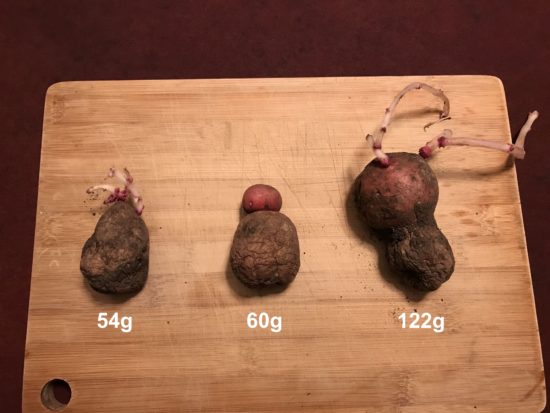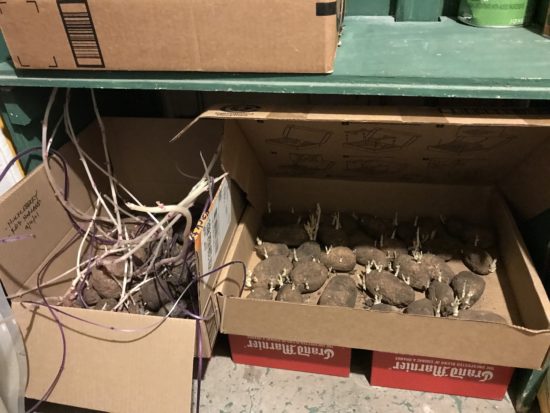Check out these potatoes I pulled out of basement storage on Valentine’s Day.

Variety: Red Pontiac
They’re not only holiday-appropriate pink, but they’re a model of love. Or parasitism, depending on your perspective. From the original harvested spud, emerging like Athena from Zeus’s head is the next generation (or, Minerva from Jupiter, as Thomas Jefferson said) – taking its nourishment from the shriveling body of its elder.
That’s really an interesting growth pattern which I haven’t seen in other potato varieties before.
Potatoes are more exciting than people might think. – or if not exciting, then at least anticipatory. Or unexpected. Even after exhumation, potatoes continue their respiration. They look passive, but they’re rather active.
What’s especially cool is the sequence that seems to be happening. First, shoots come out like any typical sprouting potato, but wherever a spiraling mass of them connect they seem to meld together into a new potato body which then emerges using borrowed skin. Even retaining the dirt, but with their skins growing firm and smooth and red.

The Red Pontiacs I harvested on September 25, 2021. Only 8.7 lbs. – short of my potato box system goal of 10 lbs. per box. They’ve been in storage roughly five months. Along the way, I ate about 60% of them, and then on 2/14/22 felt in the mood for mashed potatoes. Little did I expect that 10% would be in an advanced state of living and thriving. Although I’m kicking myself for mashing the remaining 30% and wish I’d only mashed like 27% to save a couple control spuds for the observational period. Because of course, I’ve weighed several and look forward to monitoring their growth in the coming weeks.
Immediate questions that come to mind:
* As the parasitic potato gains mass, will it become heavier than its host? (Big Bertha on the right there, makes me think, “yes.”)
* If so, where is the parasitic potato getting its energy? And why is it not a net balance in the closed system, like squeezing a water balloon?
I briefly considered that it might be “Little Tuber Disorder” which would again, be perfect for Valentine’s Day, a disorder. But I don’t think it’s the disease considering there’s only a single “little tuber” emerging from all the remainders rather than a spray of wart-like dinky spuds.
I’m still leaning toward the notion that this is normal Red Pontiac behavior and not a disease. As you can see below, each potato variety has responded to the five month period differently even though they’ve been in storage the same amount of time and same location. Huckleberry and Red Norlands have sprouted wild, long tendrils, while Kennebecs have remained relatively firm with just minimal, squatty sprouts. Kennebecs are often cited as being one of the best varieties for storage. For the 2021 season, they were also closest to my 10 lb. goal, with the Kennebec harvest coming in at 9.88 lbs. total.

